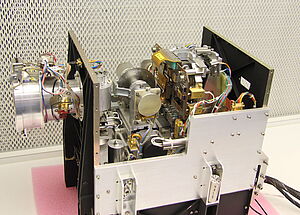MIDAS

The atomic force microscope MIDAS (Micro-Imaging Dust Analysis System) onboard Rosetta, studied the physical parameters of cometary dust, which is released as soon as the comet gets closer to the Sun. With this new method the texture of the dust particles can be measured with an accuracy of several nanometers.
In the size-distribution of cometary dust the smallest particles, with a size of micro- to nanometers, are strongly represented. The fractions of petrogenic and light elements can be determined based on the structure of the particles. MIDAS delivered information about the physical properties of the comet as a dust source. Also the development of cometary activity during the comet's approach to the Sun and the interaction between dust, gas and plasma in the neighborhood of the comet was studied.
The development of the instrument was done in an international cooperation between the directorate of science and robotic engineering of ESA and the Department of Physics of the University of Kassel under the lead of IWF Graz. In Austria Joanneum Research, Austrian Research Center Seibersdorf (now AIT), Austrian Aerospace (now RUAG Space) and the Technical University Vienna were also involved.
Further information about MIDAS can be found at ESA.